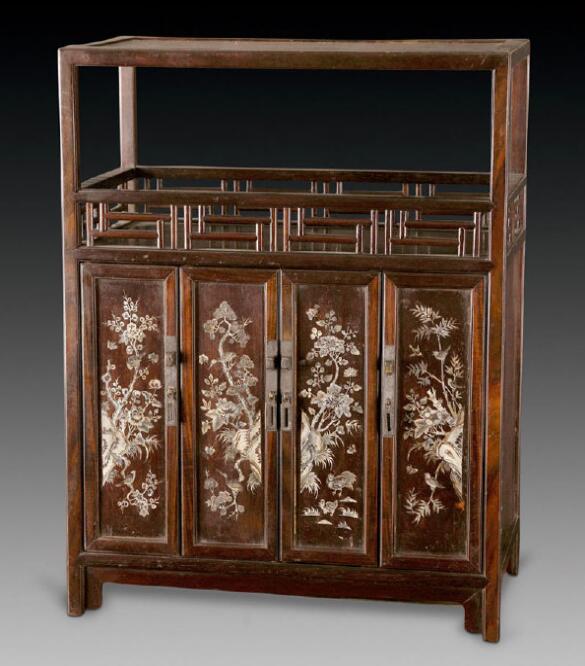万物变迁,沧海桑田,美丽奇幻、纹理多变的贝壳,作为大自然的产物,与人类结下了万年之缘。早在五万年前山顶洞人时期,贝壳就被穿成贝链作为装饰。中国的商代到秦代,贝类被打磨穿孔后,长期当作货币使用。秦汉时期,贝壳被雕出简单的鸟兽纹图样,镶嵌在铜器、镜子、屏风和桌椅上作装饰,俗称“螺钿”,这种工艺目前不少地区仍然保留着。
As a product of mother nature, the beautiful and magical time-honored shells with varied textures have shared a bond with human beings for thousands of years.Shells were worn in chains by cavemen as far back as about 50,000 years ago. From the 包養平台推薦Shang Dynasty (about BC 1600) to the Qin Dynasty (about BC 207)in China, shells were us包養網排名ed as money for a long time after being polished and perforated. During the Qin and Han dynasties (BC 221-220), shells were carved with simple patterns of birds and animals and inlaid on bronze vessels, mirrors, screens, tables and chairs for decoration. Commonly known as “mother-of-pearl”, the craft is still preserved in many regions today.

第44届世界遗产大会在福建福州举办,平潭被列为世界遗产大会的参观点之一。平潭是福建省东部沿海一个岛县,为全省第一大岛、中国第五大岛。平潭贝雕作为省级非遗项目亮相世界舞台,利用贝壳的天然色泽、纹理、形状,经过艺术构思、磨雕、粘贴,成为工艺品。
During the 44th session of the World Heritage Committee held in Fuzhou, which is the capital city of Fujian Province, Pingtan was listed as one of the visiting spots of the event. As an island county in the east coast of Fujian, Pingtan is the largest island in the province and the fifth largest island in China. Pingtan shell carving, as a provincial intangible cultural heritage project, shined on the global stage. Using the natural color, texture and shape of shells, Pingtan shell carving has turned shells into artifacts after artistic design and craftmanship.

这份美丽首先来源于自然的馈赠。平潭盛产贝、螺、蚌、蛤等海产品,形态各异、色彩斑斓。平潭贝雕在继承传统工艺的基础上,吸收玉雕、木雕和国画等众家之长,结合螺钿镶嵌工艺特点,于1955年成功创制了浮雕形式的贝雕画和多种实用工艺品,从而揭开了贝雕工艺史崭新的一页。平潭贝雕以立体、小巧、实用为主要特色,创造了贝壳堆画、立体圆雕、嵌贝漆器、嵌贝盒子和贝雕花插等5大类200多个品种。
The shell carving’s beauty is a gift of nature. Pingtan is rich in shellfish, conches, clams and other seafood with different shapes and colors. Building on traditional crafts, Pingtan shell carving also picked up skills of jade carving, wood carving and traditional Chinese painting. Combining with the features of mother-of-pearl inlay, Pingtan craftsmen created shell carving paintings in relief form and various practical handicrafts in 1955, thus opening a new page in the history of shell carving. Known for its three-dimensional, small and practical features, Pingtan shell carving has more than 200 varieties in five categories, such as shell stacking painting,包養 three-dimensional round carving, shell-inlaid lacquerware, shell-inlaid box and shell carving flower receptacle.

不同贝壳拥有不同的色泽和形状特点,平潭老艺人对它们有着巧妙的运用:带斑痕的贝壳,可锯成唯妙唯肖的树木躯干;带螺丝旋纹的贝壳,切成如云般的仕女发髻……既有刻画人物和动物形象的,又有描绘花草和山水的,多姿多彩、惟妙惟肖。
Different shells have different colors and shapes, and Pingtan veteran craftsmen have clever use of them: spotted shells can 包養be made into lifelike tree trunks; Shells with screw lines are cut into ladies’ bun… Colorful and vivid depictions of characters and animals, flowers and landscapes could be made from shells.

平潭贝雕代表着海洋文化与中原文化的碰撞,巧妙地将人与海结合起来,具有贝壳的自然美、雕塑的技法美和国画的构图美与格调美。同样是贝雕,不同的文化背景下风格却截然不同,德国、意大利等西方贝雕多以浮雕首饰为主,色彩单纯,带着宗教、偶像崇拜及纪念的烙印。
Pingtan shell carving represents the fusion between marine culture and Chinese culture. The art skillfully combines mankind with the sea, featuring the natural beauty of shells, the beauty of sculpture techniques and the beauty of composition and style of traditional Chinese painting. Shell carvings can have quite different styles under different cultural backgrounds. Western shell carvings in countries such as Germany and Italy are mainly embossed jewelry, with simple colors and religious, idolatry and commemorative elements.
如今随着中外文化的交流和互通,越来越多的人关注并加入贝雕技艺的传承与保护中来,这把“艺术薪火”又被重新点燃和烧旺。
With the exchange and intercommunication of Chinese and foreign cultures, shell carving is gaining包養 growing attention and participation in its inheritance and protection. The time-honored art is enjoying a new breath of life.
發佈留言